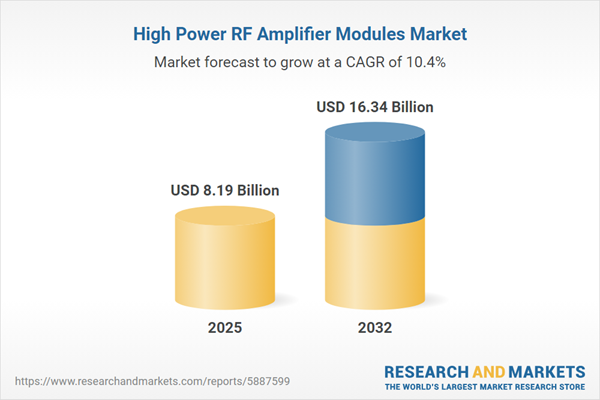Speak directly to the analyst to clarify any post sales queries you may have.
High power RF amplifier modules are essential for organizations aiming to future-proof network infrastructure, support reliable operations, and accommodate fast-changing connectivity demands across sectors. Their adaptability positions them as fundamental components in modern technology-driven enterprises.
Market Snapshot: High Power RF Amplifier Modules Market Size & Growth
The global high power RF amplifier modules market reached USD 7.43 billion in 2024, with an expected rise to USD 8.19 billion by 2025 and projections topping USD 16.34 billion by 2032. Market expansion is driven by network densification initiatives, widespread 5G deployments, heightened demand for satellite communications, and continuous advancements in the defense sector. Material developments, particularly involving gallium nitride and gallium arsenide, further enhance module efficiency and system reliability. These trends are visible across telecommunications, industrial automation, enterprise IT, and consumer electronics, reflecting growing cross-sector adoption and integration.
Scope & Segmentation of the High Power RF Amplifier Modules Market
This report enables business leaders to align investment, procurement, and technology strategy through detailed segmentation and regional insights:
- Application Areas: Covers consumer electronics for residential and broadcast usage, advanced radar and electronic warfare solutions within defense, scientific instrumentation and industrial diagnostics, as well as connectivity for both cellular and satellite telecommunications.
- Key Technologies: Includes gallium arsenide (GaAs) semiconductor technology, heterojunction bipolar and high electron mobility transistors, gallium nitride (GaN) on silicon and silicon carbide, LDMOS, and silicon-based solutions designed to meet varied operational demands.
- Frequency Bands: Modules support a broad spectrum, including microwave bands such as C, Ka, Ku, S, and X, millimeter wave V and W bands, plus ultra-high frequency spectra, accommodating specialized and general communications needs.
- Power Output Classifications: Addresses low, medium, high, and ultra-high output requirements, allowing precise module selection and scalability in deployment for stable operations.
- Architecture Types: Encompasses hybrid and multistage (including two-stage and three-stage) as well as single-stage layouts, supporting both expansive infrastructure and focused, specialist applications.
- Regional Coverage: Spans North America, Latin America, Europe, Middle East, Africa, and Asia-Pacific, highlighting significant growth in areas such as China, India, Southeast Asia, Japan, Australia, and South Korea. Local policies and varied adoption influence the pace of market development in each region.
- Leading Market Participants: Identifies primary vendors such as NXP Semiconductors N.V., Qorvo, Inc., Analog Devices, MACOM Technology Solutions, Ampleon Netherlands B.V., Infineon Technologies AG, Mitsubishi Electric Corporation, L3Harris Technologies, Teledyne Technologies, and Empower RF Systems, providing benchmarking criteria and partnership considerations for industry leaders.
Key Takeaways for Senior Decision-Makers
- Emerging semiconductor materials significantly increase power density and extend module durability, bolstering operational reliability in mission-critical and field environments.
- Modular and scalable product architectures facilitate seamless system upgrades and feature integration, helping minimize business interruption during technology transitions.
- Comprehensive frequency support enhances flexibility for R&D and deployment teams, making custom and mainstream applications more viable in diverse commercial and industrial contexts.
- New collaboration models—uniting RF, power electronics, and signal processing expertise—streamline deployments and promote cohesive system performance.
- Procurement strategies are evolving toward geographically localized supply chains to strengthen agility and meet compliance pressures in dynamic trade environments.
- Distinctive market positions are materializing through advances in material science, support for multi-band operations, and modular output categories tailored to unique sector requirements.
Tariff Impact: Strategic Supply Chain Considerations
Amid changing U.S. tariff policies on semiconductor imports, industry players are adapting their sourcing and logistics patterns for high power RF amplifier modules. Fostering partnerships with regional suppliers and prioritizing preferred trade zones are increasingly important to mitigate regulatory risk and uphold consistent delivery of time-sensitive components. Building resilient and responsive local supply networks helps organizations counter unforeseen supply chain challenges and evolving policy landscapes.
Methodology & Data Sources
This overview synthesizes input from executive interviews, technical expert consultations, in-depth industry reports, regulatory filings, and presentations at major industry events. Collectively, these sources support informed resolutions for senior leadership navigating the high power RF amplifier modules sector.
Why This High Power RF Amplifier Modules Report Matters
- Enables executive teams to track innovation trends in core technologies, supporting alignment of R&D and modernization efforts with shifting market needs.
- Equips procurement and operational leaders with actionable insights to proactively adjust supplier relationships and sourcing models, enhancing resilience.
- Strengthens organizational strategies to address evolving regional and technical challenges, enabling improved risk management and operational performance.
Conclusion
Focusing investment and technology planning around high power RF amplifier modules allows organizations to anticipate shifts in industry requirements and maintain robust, future-ready operations in complex markets.
Additional Product Information:
- Purchase of this report includes 1 year online access with quarterly updates.
- This report can be updated on request. Please contact our Customer Experience team using the Ask a Question widget on our website.
Table of Contents
3. Executive Summary
4. Market Overview
7. Cumulative Impact of Artificial Intelligence 2025
Companies Mentioned
The companies profiled in this High Power RF Amplifier Modules market report include:- NXP Semiconductors N.V.
- Qorvo, Inc.
- Analog Devices, Inc.
- MACOM Technology Solutions Holdings, Inc.
- Ampleon Netherlands B.V.
- Infineon Technologies AG
- Mitsubishi Electric Corporation
- L3Harris Technologies, Inc.
- Teledyne Technologies, Inc.
- Empower RF Systems, Inc.
Table Information
| Report Attribute | Details |
|---|---|
| No. of Pages | 199 |
| Published | October 2025 |
| Forecast Period | 2025 - 2032 |
| Estimated Market Value ( USD | $ 8.19 Billion |
| Forecasted Market Value ( USD | $ 16.34 Billion |
| Compound Annual Growth Rate | 10.3% |
| Regions Covered | Global |
| No. of Companies Mentioned | 11 |









